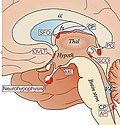Circumventricular organs
Circumventricular Organs (CVOs) are structures in the brain that are characterized by their position around the ventricular system and their extensive vascularization. They are part of the neuroendocrine system and play a crucial role in the homeostasis of the body.
Overview[edit]
CVOs are unique in that they are located in the brain but lack a blood-brain barrier, which allows them to directly interact with substances in the bloodstream. This unique feature allows them to perform essential functions such as the detection of systemic changes in blood composition, the regulation of thirst and hunger, and the modulation of body temperature and blood pressure.
Classification[edit]
CVOs can be classified into two categories: sensory and secretory.
Sensory CVOs[edit]
Sensory CVOs, also known as circumventricular sensory organs, are responsible for detecting changes in the body's internal environment. They include the organum vasculosum of the lamina terminalis (OVLT), the subfornical organ (SFO), and the area postrema (AP).
Secretory CVOs[edit]
Secretory CVOs, also known as circumventricular secretory organs, are involved in the secretion of hormones into the bloodstream. They include the median eminence, the pineal gland, and the subcommissural organ (SCO).
Function[edit]
CVOs play a crucial role in maintaining the body's homeostasis. They are involved in a variety of physiological processes, including the regulation of water balance, energy metabolism, body temperature, and blood pressure. They also play a role in the body's response to stress and inflammation.
Clinical Significance[edit]
Due to their unique position and function, CVOs are implicated in a variety of diseases and conditions. For example, they can be affected by systemic inflammation, leading to changes in behavior and physiological responses. They are also involved in the regulation of body weight, and their dysfunction can contribute to obesity and other metabolic disorders.
See Also[edit]
References[edit]
<references />
Ad. Transform your life with W8MD's Budget GLP-1 injections from $75


W8MD offers a medical weight loss program to lose weight in Philadelphia. Our physician-supervised medical weight loss provides:
- Weight loss injections in NYC (generic and brand names):
- Zepbound / Mounjaro, Wegovy / Ozempic, Saxenda
- Most insurances accepted or discounted self-pay rates. We will obtain insurance prior authorizations if needed.
- Generic GLP1 weight loss injections from $75 for the starting dose.
- Also offer prescription weight loss medications including Phentermine, Qsymia, Diethylpropion, Contrave etc.
NYC weight loss doctor appointmentsNYC weight loss doctor appointments
Start your NYC weight loss journey today at our NYC medical weight loss and Philadelphia medical weight loss clinics.
- Call 718-946-5500 to lose weight in NYC or for medical weight loss in Philadelphia 215-676-2334.
- Tags:NYC medical weight loss, Philadelphia lose weight Zepbound NYC, Budget GLP1 weight loss injections, Wegovy Philadelphia, Wegovy NYC, Philadelphia medical weight loss, Brookly weight loss and Wegovy NYC
|
WikiMD's Wellness Encyclopedia |
| Let Food Be Thy Medicine Medicine Thy Food - Hippocrates |
Medical Disclaimer: WikiMD is not a substitute for professional medical advice. The information on WikiMD is provided as an information resource only, may be incorrect, outdated or misleading, and is not to be used or relied on for any diagnostic or treatment purposes. Please consult your health care provider before making any healthcare decisions or for guidance about a specific medical condition. WikiMD expressly disclaims responsibility, and shall have no liability, for any damages, loss, injury, or liability whatsoever suffered as a result of your reliance on the information contained in this site. By visiting this site you agree to the foregoing terms and conditions, which may from time to time be changed or supplemented by WikiMD. If you do not agree to the foregoing terms and conditions, you should not enter or use this site. See full disclaimer.
Credits:Most images are courtesy of Wikimedia commons, and templates, categories Wikipedia, licensed under CC BY SA or similar.
Translate this page: - East Asian
中文,
日本,
한국어,
South Asian
हिन्दी,
தமிழ்,
తెలుగు,
Urdu,
ಕನ್ನಡ,
Southeast Asian
Indonesian,
Vietnamese,
Thai,
မြန်မာဘာသာ,
বাংলা
European
español,
Deutsch,
français,
Greek,
português do Brasil,
polski,
română,
русский,
Nederlands,
norsk,
svenska,
suomi,
Italian
Middle Eastern & African
عربى,
Turkish,
Persian,
Hebrew,
Afrikaans,
isiZulu,
Kiswahili,
Other
Bulgarian,
Hungarian,
Czech,
Swedish,
മലയാളം,
मराठी,
ਪੰਜਾਬੀ,
ગુજરાતી,
Portuguese,
Ukrainian



